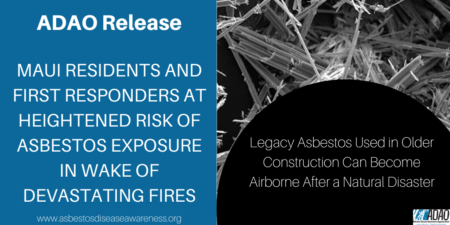Posted on August 16, 2023
FOR IMMEDIATE RELEASE
MAUI RESIDENTS AND FIRST RESPONDERS AT HEIGHTENED RISK OF ASBESTOS EXPOSURE IN WAKE OF DEVASTATING FIRES
Legacy Asbestos Used in Older Construction Can Become Airborne After a Natural Disaster
 Washington, DC — The Asbestos Disease Awareness Organization (ADAO), an independent nonprofit dedicated to preventing asbestos exposure, today warned Maui residents and first responders about the heightened risk of asbestos exposure in the wake of the fires that have devastated their community.
Washington, DC — The Asbestos Disease Awareness Organization (ADAO), an independent nonprofit dedicated to preventing asbestos exposure, today warned Maui residents and first responders about the heightened risk of asbestos exposure in the wake of the fires that have devastated their community.
“The Maui community is devastated and has already lost far too much,” said ADAO president and co-founder Linda Reinstein, “We must raise awareness about the threat of asbestos exposure at this critical time to prevent the onset of asbestos-caused illness and disease as a result of this tragedy. Our thoughts and prayers go out to all the residents and first responders who are working to save lives and rebuild their community,” she said.
Asbestos exposure following a natural disaster is a significant concern, particularly in regions with older structures that can contain asbestos-containing materials. Asbestos is a known human carcinogen and there is no safe level of asbestos exposure. Asbestos was widely used throughout the United States for a variety of purposes through the 1980s. Although its use has declined, it is still imported and used in the United States today. The only way to truly stay safe from asbestos is to prevent exposure from occurring.
In the wake of natural disasters like fires, floods, and hurricanes, asbestos fibers that were used in older structures that have been ravaged can become airborne, which can create serious health risks. It is critical to recognize and mitigate these risks to prevent further loss of life.
Asbestos can be found in a variety of materials, including:
- Insulation
- Floor Tiles, especially vinyl tiles
- Cementitious, Roofing and Siding Shingles
- Asphaltic roofing materials, especially on commercial buildings.
- Textured Ceiling Treatments, and Patching Compounds
- Walls and Floors
- Hot Water and Steam Pipes insulation
- Oil and Coal Furnaces insulation
- Automotive Parts including brake pads and linings, clutch facings, and gaskets.
Regularly update yourself with reports from local health departments, emergency services, and environmental agencies about asbestos hazards in affected zones. However, keep in mind, in the immediate aftermath of a disaster, this information may not be immediately available. Take precautionary steps to protect yourself and prevent accidental exposure.
To Prevent Exposure To Asbestos Following A Natural Disaster:
- Seek Expert Assistance: If you suspect asbestos contamination on your property, promptly engage an asbestos professional. Such specialists can conduct asbestos tests, evaluate risks, and guide further action.
- Avoid Damaged Buildings: Refrain from entering damaged structures, particularly older ones. Disruptions may release asbestos fibers.
- Take Personal Protection and Decontamination Measures
- Wear, use, and dispose of Personal Protective Equipment (PPE) following guidelines for safe and secure use.
- Use masks with suitable filtration, preferably N95 respirators or better.
- Protect Others: To keep others safe, avoid carrying asbestos fibers out of a worksite where they can later be inhaled by others (e.g., by family members at home).
- Wear protective outer clothing and gloves that can be removed and discarded.
- Wash exposed parts of the body with soap and water.
- Limit Dust Generation: If you need to be in affected areas, wet the debris to curb dust. Clean with wet rags or mops and dispose of them properly afterward.
- Avoid Sweeping or Vacuuming: These actions can render asbestos airborne.
- Proper Waste Disposal: Dispose of potential asbestos-containing debris in sealed, leak-proof containers. Abide by local guidelines for the appropriate disposal of asbestos waste.
- Isolate the Area: If an area is suspected to have asbestos, restrict its access. Use barriers, barrier tape, or cones to demarcate the zone.
- Renovation & Demolition: For damaged asbestos-containing facilities, enlist a licensed asbestos removal contractor for repairs or demolition. They possess the required skills, state licensing, and tools to handle such hazards.
- Educate Others: If you’re in a leadership or influential role, disseminate this knowledge among peers, neighbors, and family to maintain communal safety.
More information is available from the Environmental Protection Agency in their publication on Dealing with Debris and Damaged Buildings or from the Occupational Safety and Health Agency’s Asbestos Guide for Workers and Professionals.
###
ABOUT ASBESTOS DISEASE AWARENESS ORGANIZATION
Founded in 2004, the Asbestos Disease Awareness Organization (ADAO) is the largest independent 501(c)(3) nonprofit in the U.S. dedicated to preventing asbestos exposure to eliminate asbestos-related diseases through education, advocacy, and community initiatives.
